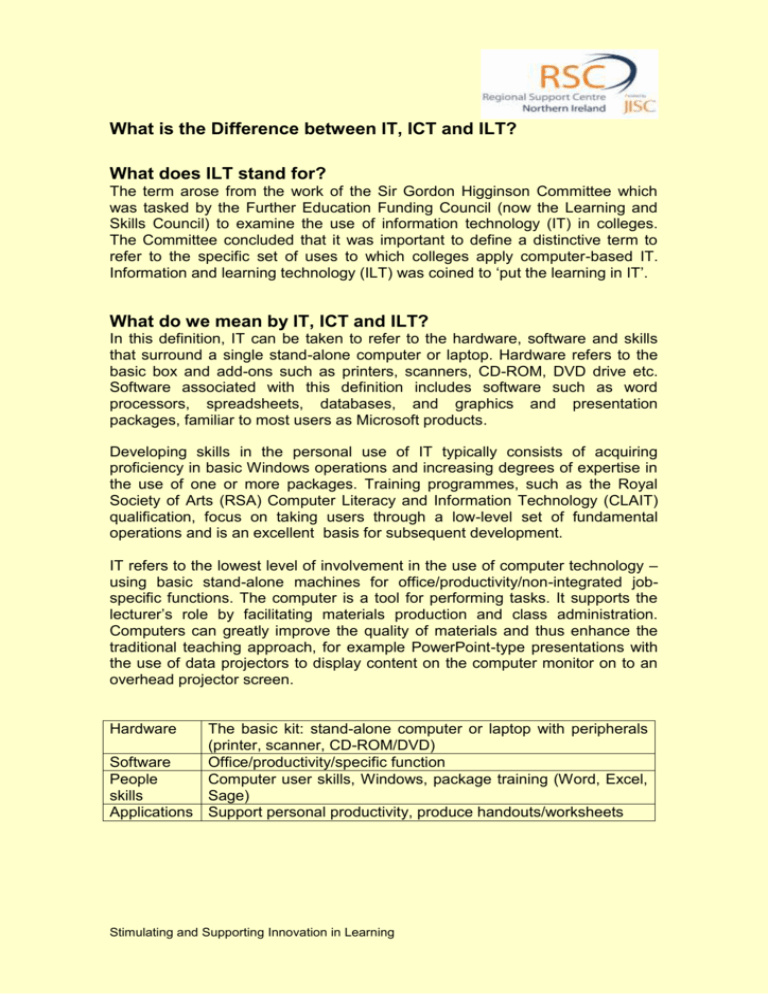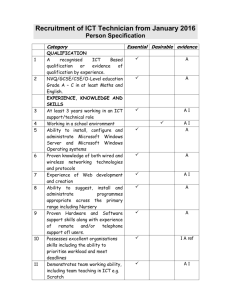Module B explores the benefits that using ILT can bring to your
advertisement

What is the Difference between IT, ICT and ILT? What does ILT stand for? The term arose from the work of the Sir Gordon Higginson Committee which was tasked by the Further Education Funding Council (now the Learning and Skills Council) to examine the use of information technology (IT) in colleges. The Committee concluded that it was important to define a distinctive term to refer to the specific set of uses to which colleges apply computer-based IT. Information and learning technology (ILT) was coined to ‘put the learning in IT’. What do we mean by IT, ICT and ILT? In this definition, IT can be taken to refer to the hardware, software and skills that surround a single stand-alone computer or laptop. Hardware refers to the basic box and add-ons such as printers, scanners, CD-ROM, DVD drive etc. Software associated with this definition includes software such as word processors, spreadsheets, databases, and graphics and presentation packages, familiar to most users as Microsoft products. Developing skills in the personal use of IT typically consists of acquiring proficiency in basic Windows operations and increasing degrees of expertise in the use of one or more packages. Training programmes, such as the Royal Society of Arts (RSA) Computer Literacy and Information Technology (CLAIT) qualification, focus on taking users through a low-level set of fundamental operations and is an excellent basis for subsequent development. IT refers to the lowest level of involvement in the use of computer technology – using basic stand-alone machines for office/productivity/non-integrated jobspecific functions. The computer is a tool for performing tasks. It supports the lecturer’s role by facilitating materials production and class administration. Computers can greatly improve the quality of materials and thus enhance the traditional teaching approach, for example PowerPoint-type presentations with the use of data projectors to display content on the computer monitor on to an overhead projector screen. Hardware The basic kit: stand-alone computer or laptop with peripherals (printer, scanner, CD-ROM/DVD) Software Office/productivity/specific function People Computer user skills, Windows, package training (Word, Excel, skills Sage) Applications Support personal productivity, produce handouts/worksheets Stimulating and Supporting Innovation in Learning Information and communications technology (ICT) incorporates the networking together of computers. This allows computers to do tasks more effectively, insofar as making available a wider range of shared software held centrally on servers and can make management of the system easier and more efficient. The key to ICT, however, is in the possibilities for communication, both within and between institutions. Within a college, the most obvious immediate impact is likely to come from email between staff and access to college databases, notably student and course information, together with full management information system data. Externally, there are possibilities for links with other colleges, validating and funding agencies, and with the vast information and communication resources of the World Wide Web. The software to move from IT to ICT includes communications software, such as e.g. Microsoft Outlook, browser software such as Internet Explorer, and web authoring packages such as Dreamweaver. The capability to produce and maintain a college web site, or its internal equivalent, an intranet, opens new opportunities for communications. The people skills involved can be classified as user/receiver (browsing, reading e-mail) or creator/sender (web authoring, sending e-mail). ICT Machines are networked together allowing communication with others on the network and in the outside world via e-mail and the Internet. The computer is a tool for performing tasks and communicating with others. ICT is defined as the interconnection of stand-alone computers across and between institutions, and is a general set of tools and skills that can be applied to a wide range of organisations. It offers the potential to pull together virtual communities/organisations that’s only, or main, point of contact is the Internet. Hardware Software People skills Applications Networking together of machines, ideally into a single unified network with access to server-based materials and functions including e-mail, intranet, college information systems and the Internet Microsoft Outlook, Internet Explorer/Netscape, Dreamweaver Use of e-mail/communications technology, web browsing/web authoring Interaction with peers/students and external bodies. Sharing of software and materials via network/intranet ILT is about the application of IT/ICT to education. So it begins with an understanding of the needs and possibilities for learning. By first considering what students wish to accomplish, it is then possible to look at how the new technologies might make this more possible, by widening participation or increasing engagement, and how they might contribute to raising standards of attainment and the quality of learner experience. It is also possible to look at how the professional skills of tutors and all those supporting learning can be Stimulating and Supporting Innovation in Learning enhanced by adding these new tools to those that already exist, and how the business of the college can be more effectively conducted by all staff. The current state of development of IT/ICT, and particularly the growth of internet-based information services, gives us a significant opportunity to change the way we work to the benefit of all. ILT is about choices that we make for our learners and our colleges that will change the culture. ILT is the application of IT/ICT to the core business of further education. In learning, ILT is characterised by the use of ICT to deliver learning materials/experiences and may extend to on-line guidance, assessment and recording of progress. Alternatively, it may support traditional/off-line learning. Hardware Software People skills Applications In its simplest form, any systems used for IT/ICT. There are endless possibilities for incorporating other systems, for example data projection hardware. Those used for IT/ICT, CD-ROM/web-based learning materials and knowledge resources Using IT/ICT to facilitate learning and to administer and manage learning and the business activities of the college; exploiting communications technology to create learning and teaching media in a culture which celebrates the possibilities of on-line education Enhancing the learning experience and creating alternative forms of delivery. Stimulating and Supporting Innovation in Learning IT, ICT and ILT Definitions and differences IT ICT Refers to the basic set of components and their uses. Linking the components together and hooking them up to a network – intranet/extranet or Internet. Associated with training in: switching on/off basic operations office applications (eg Microsoft) CLAIT or similar. Associated with training in: use of CD-ROMs e-mail video conferencing Internet/intranet/web design etc. Enables production of high quality handouts to support traditional teaching methods. Takes the lecturer outside their own department – via e-mail/intranet to the rest of the college and via internet to the world beyond. Enables lecturers to teach Microsoft Office, CLAIT and similar tools. Enables communication/information gathering/searching. Stimulating and Supporting Innovation in Learning ILT Using IT/ICT to facilitate/enliven/improve the standard and effectiveness of learning. Associated with training in the use of IT/ICT as a tool to deliver, support and assess learning in all subject areas. Takes the lecturer into the new culture. Enables a new approach in teaching and learning, fully supported by the government as seem in the monies given to Colleges to acquire the necessary equipment to support this new culture. Stimulating and Supporting Innovation in Learning





